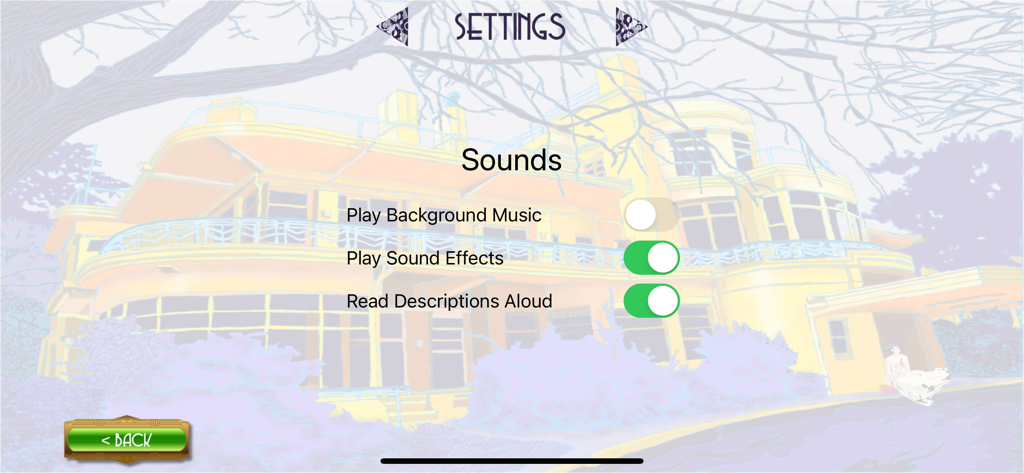In final part of my multipart article on converting my Murdered by Midnight Board Game to a Mobile Game App using Swift and SwiftUI, I’ll cover supporting Music, Sound Effects & Voice in my Multiplatform SwiftUI game.
Hopefully, other indie developers can find this information useful.
Index:
- Part 1 – Deals with converting a mockup to SwiftUI, handling different device sizes & screen ratios and displays screens as needed.
- Part 2 – Covers adding Game Center support to a SwiftUI app.
- Part 3 – Covers handling tvOS quirks in a SwiftUI app.
- Part 4 – Covers handling macOS Catalyst quirks in a SwiftUI app.
- Bonus Round – Covers handling Music, Sound Effects & Voice in a SwiftUI app.
Handling Background Music and Sound Effects
I knew I want to have background music in my game, along with the ability to play a few sound effects at the same time, over this music. Here is the common class that I cooked up to handle everything:
import Foundation
import AVFoundation
import SwiftUI
/// Class to handle playing background music and sound effects throughout the game.
class SoundManager: NSObject, AVAudioPlayerDelegate {
typealias FinishedPlaying = () -> Void
// MARK: - Enumerations
/// Defines which channel the sound effect will be played through.
enum SoundEffectChannel:Int {
/// Play through channel 1.
case channel01 = 0
/// Play through channel 2.
case channel02 = 1
}
// MARK: - Static Properties
/// Defines the common, shared instance of the Sound Manager
static var shared:SoundManager = SoundManager()
// MARK: - Properties
/// Global variable that if `true`, background music will be played in the game.
@AppStorage("playBackgroundMusic") var shouldPlayBackgroundMusic: Bool = true
/// Global variable that if `true`, sound effect will be played in the game.
@AppStorage("playSoundEffects") var shouldPlaySoundEffects: Bool = true
/// The `AVAudioPlayer` used to play background music.
var backgroundMusic:AVAudioPlayer?
/// The sound currently being played in the background music channel.
var currentBackgroundMusic:String = ""
/// The `AVAudioPlayer` used to play room specific background music.
var backgroundSound:AVAudioPlayer?
/// The `AVAudioPlayer` used to play the first channel of sound effects.
var soundEffect01:AVAudioPlayer?
/// The `AVAudioPlayer` used to play the second channe; of sound effects.
var soundEffect02:AVAudioPlayer?
/// The delegate used to handle events on the first channel of sound effects.
private var soundEffectDelegate01:SoundManagerDelegate? = nil
/// The delegate used to handle events on the second channel of sound effects.
private var soundEffectDelegate02:SoundManagerDelegate? = nil
// MARK: - Functions
/// Starts playing the background music for the given audio file. If the sound is already playing, it will not be restarted. The sound provided will loop forever until `stopBackgroundMusic()` is called.
/// - Parameter song: The sound (with extension) to be played.
func startBackgroundMusic(song:String) {
guard shouldPlayBackgroundMusic else {
return
}
// Is the song already playing?
guard currentBackgroundMusic != song else {
return
}
if let backgroundMusic = backgroundMusic {
if backgroundMusic.isPlaying {
stopBackgroundMusic()
}
}
let path = Bundle.main.path(forResource: song, ofType:nil)
if let path = path {
let url = URL(fileURLWithPath: path)
do {
currentBackgroundMusic = song
backgroundMusic = try AVAudioPlayer(contentsOf: url)
backgroundMusic?.volume = 0.30
backgroundMusic?.numberOfLoops = -1
backgroundMusic?.play()
} catch {
print("Unable to play background music: \(error)")
}
} else {
print("Unable find background music: \(song)")
}
}
/// Thapls the room specific background music. The sound provided will loop forever until `stopBackgroundSound()` is called.
/// - Parameter sound: The sound (with extension) to be played.
func playBackgroundSound(sound:String) {
guard shouldPlayBackgroundMusic else {
return
}
if let backgroundSound = backgroundSound {
if backgroundSound.isPlaying {
stopBackgroundSound()
}
}
let path = Bundle.main.path(forResource: sound, ofType:nil)
if let path = path {
let url = URL(fileURLWithPath: path)
do {
backgroundSound = try AVAudioPlayer(contentsOf: url)
backgroundSound?.play()
} catch {
print("Unable to play background music: \(error)")
}
} else {
print("Unable find background music: \(sound)")
}
}
/// Stops the currently playing background music.
func stopBackgroundMusic() {
backgroundMusic?.stop()
currentBackgroundMusic = ""
backgroundMusic = nil
}
/// Stops the currently playing room specific background music.
func stopBackgroundSound() {
backgroundSound?.stop()
backgroundSound = nil
}
/// Plays the given sound effect on the given effect channel.
/// - Parameters:
/// - sound: The sound (with extension) to be played.
/// - channel: The effect channel to play the song on. The default is `channel01`.
/// - didFinishPlaying: The closure that will be called when the sound finishes playing.
func playSoundEffect(sound:String, channel:SoundEffectChannel = .channel01, didFinishPlaying:FinishedPlaying? = nil) {
guard shouldPlaySoundEffects else {
if let didFinishPlaying = didFinishPlaying {
didFinishPlaying()
}
return
}
let path = Bundle.main.path(forResource: sound, ofType:nil)
if let path = path {
let url = URL(fileURLWithPath: path)
do {
switch(channel) {
case .channel01:
soundEffectDelegate01 = SoundManagerDelegate(action: didFinishPlaying)
soundEffect01 = try AVAudioPlayer(contentsOf: url)
soundEffect01?.delegate = soundEffectDelegate01
soundEffect01?.play()
case .channel02:
soundEffectDelegate02 = SoundManagerDelegate(action: didFinishPlaying)
soundEffect02 = try AVAudioPlayer(contentsOf: url)
soundEffect02?.delegate = soundEffectDelegate02
soundEffect02?.play()
}
} catch {
print("Unable to play sound effect: \(error)")
}
} else {
print("Unable find sound effect: \(sound)")
}
}
}
/// Delegate that handles a sound finishing playing on one of the sound effect channels.
class SoundManagerDelegate: NSObject, AVAudioPlayerDelegate {
typealias FinishedPlaying = () -> Void
// MARK: - Properties
/// The closure that gets called when the sound finishes playing.
var finishPlaying:FinishedPlaying? = nil
// MARK: - Initializers
/// Creates a new instance of the object with the given parameters.
/// - Parameter action: The closure that gets called when the sound finishes playing.
init(action:FinishedPlaying?) {
// Initialize
self.finishPlaying = action
}
// MARK: - Functions
/// Function called when the sound finishes playing
/// - Parameters:
/// - player: The `AVAudioPlayer` that was playing the sound.
/// - flag: If `true`, the sound played successfully.
func audioPlayerDidFinishPlaying(_ player: AVAudioPlayer, successfully flag: Bool) {
if let finishPlaying = finishPlaying {
finishPlaying()
}
}
}All playback is handled by a standard AVAudioPlayer. Here’s what all of the functions in the class do:
startBackgroundMusic(song:String)– Play the give music on a loop if the user wants to hear background music and the given song is not already playing.playBackgroundSound(sound:String)– Layers a background sound on top of the music that does not loop.stopBackgroundMusic()– Instantly stops any background music.stopBackgroundSound()– Instantly stops any background sound effect.playSoundEffect(sound:String, channel:SoundEffectChannel = .channel01, didFinishPlaying:FinishedPlaying? = nil)– Plays the given sound effect on the given channel. UsedidFinishPlayingto take an action after the effect ends.SoundManagerDelegate– Handles a sound effect finishing playing.
When I use this class in the game, I make a call against the shared instance:
import SwiftUI
import SwiftletUtilities
import GameKitUI
import GameKit
struct StartGameView: View {
@ObservedObject var dataStore = MasterDataStore.sharedDataStore
...
var body: some View {
GeometryReader { geometry in
ZStack(alignment: .topLeading) {
...
}
.ignoresSafeArea()
}
.ignoresSafeArea()
.onAppear {
SoundManager.shared.startBackgroundMusic(song: "AnechoixJazzLoop.mp3")
}
}
}Handling Speech Synthesis
To make the game a little quirky and different, I knew I wanted to have each character’s part read aloud. While it would have been nice to have gotten a bunch of voice actors to record all of the different parts, my limited budget just didn’t allow for it.
So I decided to see how far I could push Siri’s text-to-speech functionality. With a little experimentation, I was able to get a couple of different voices programmatically to add a little interest.
Here’s the shared library I ended up creating to handle everything:
import Foundation
import AVFoundation
import SwiftUI
class SpeechManager {
// MARK: - Static Functions
static var shared:SpeechManager = SpeechManager()
// MARK: - Enumerations
public enum VoiceLanguage: String {
case arabicSaudiArabia = "ar-SA"
case czechCzechRepublic = "cs-CZ"
case danishDenmark = "da-DK"
case germanGermany = "de-DE"
case greekModernGreece = "el-GR"
case englishAustralia = "en-AU"
case englishUnitedKingdom = "en-GB"
case englishIreland = "en-IE"
case englishIndia = "en-IN"
case englishUnitedStates = "en-US"
case englishSouthAfrica = "en-ZA"
case spanishMexico = "es-MX"
case spanishSpain = "es-ES"
case finnishFinland = "fi-FI"
case frenchCanada = "fr-CA"
case frenchFrance = "fr-FR"
case hebrewIsrael = "he-IL"
case hindiIndia = "hi-IN"
case indonesianIndonesia = "id-ID"
case italianItaly = "it-IT"
case japaneseJapan = "ja-JP"
case koreanKorea = "ko-KR"
case dutchBelgium = "nl-BE"
case dutchNetherlands = "nl-NL"
case norwegianNorway = "no-NO"
case polishPoland = "pl-PL"
case portugueseBrazil = "pt-BR"
case portuguesePortugal = "pt-PT"
case romanianRomania = "ro-RO"
case russianRussianFederation = "ru-RU"
case slovakSlovakia = "sk-SK"
case swedishSweden = "sv-SE"
case thaiThailand = "th-TH"
case turkishTurkey = "tr-TR"
case chineseShina = "zh-CN"
case chineseHongKong = "zh-HK"
case chineseTaiwan = "zh-TW"
}
// MARK: - Properties
@AppStorage("speakText") var speakText: Bool = true
var speechSynthesizer:AVSpeechSynthesizer = AVSpeechSynthesizer()
// MARK: - Functions
/// Uses the default **Speech Synthesizer** to speak the given text aloud.
/// - Parameter text: The text to read aloud to the user.
func sayPhrase(_ text:String) {
guard speakText else {
return
}
let speechUtterance = AVSpeechUtterance(string: text)
speechSynthesizer.speak(speechUtterance)
}
/// Says the given phrase in the given language.
/// - Parameters:
/// - text: The text to speak.
/// - inVoice: The language to speak in.
func sayPhrase(_ text:String, inVoice:VoiceLanguage) {
guard speakText else {
return
}
let speechSynthesisVoice = AVSpeechSynthesisVoice(language: inVoice.rawValue)
let speechUtterance = AVSpeechUtterance(string: text)
speechUtterance.voice = speechSynthesisVoice
speechSynthesizer.speak(speechUtterance)
}
/// Stops any speech currently running.
func stopSpeaking() {
guard speakText else {
return
}
speechSynthesizer.stopSpeaking(at: .word)
}
}This code is really pretty simple, the only thing I did “special” was to take all of the languages that can be spoken on iOS and add them to an enum (VoiceLanguage) to make them a little more “human readable”.
In the game I used it like this:
.onAppear{
DispatchQueue.main.async {
if dataStore.dontAnnounce {
dataStore.dontAnnounce = false
} else {
let person = dataStore.getCharacter(id: dataStore.lastConversation.avatar)!
if dataStore.lastConversation.sex == .female {
switch(person.nationality) {
case .irish:
SpeechManager.shared.sayPhrase(dataStore.lastConversation.text, inVoice: .englishIreland)
case .german:
SpeechManager.shared.sayPhrase(dataStore.lastConversation.text, inVoice: .germanGermany)
case .british, .french:
SpeechManager.shared.sayPhrase(dataStore.lastConversation.text, inVoice: .englishSouthAfrica)
default:
SpeechManager.shared.sayPhrase(dataStore.lastConversation.text, inVoice: .englishUnitedStates)
}
} else {
switch(person.nationality) {
case .british, .scottish:
SpeechManager.shared.sayPhrase(dataStore.lastConversation.text, inVoice: .englishIndia)
case .french:
SpeechManager.shared.sayPhrase(dataStore.lastConversation.text, inVoice: .frenchFrance)
default:
SpeechManager.shared.sayPhrase(dataStore.lastConversation.text, inVoice: .englishUnitedKingdom)
}
}
}
}The only part that is of real interest here, is that I had to call speech synthesis on the main thread or it caused the app to go crazy.
Support
If you find this useful, please consider making a small donation:
It’s through the support of contributors like yourself, I can continue to create useful articles like this one and continue build, release and maintain high-quality, well documented Swift Packages for free.
Closing
For those of you who stuck with me through the entire article, thanks! And I hope you did find some useful information.


